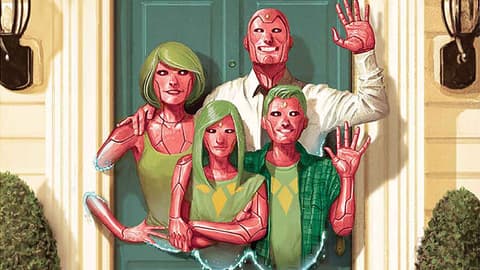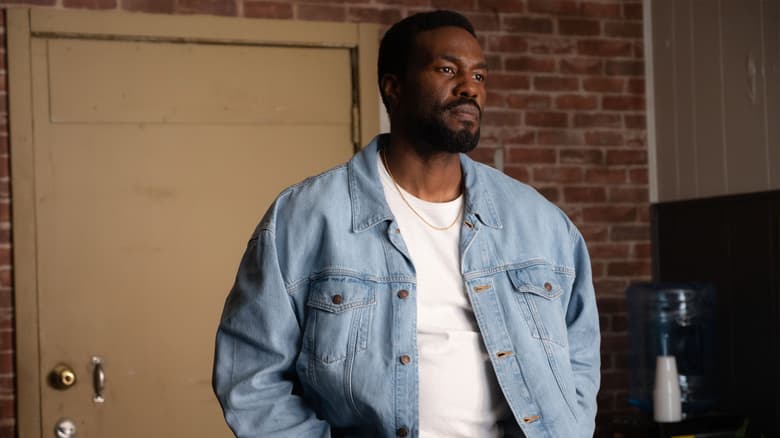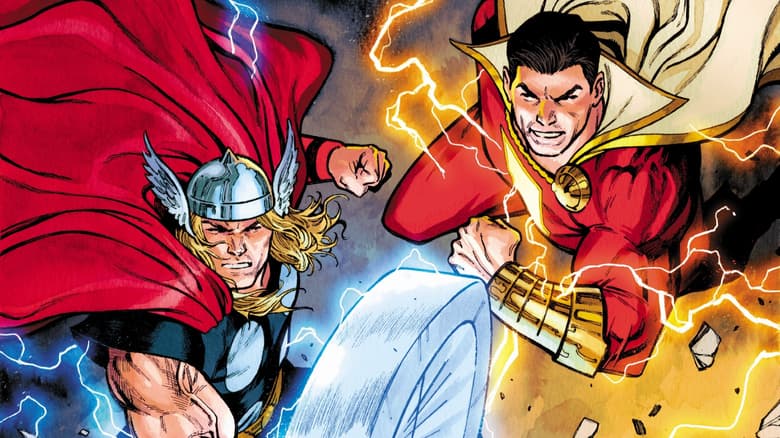A Vision of the Future
Writer Tom King takes us inside the process for his critically acclaimed work!

Sometime when something works so well, you want to take it apart to see what makes it tick.
That’s the idea in the VISION: DIRECTOR’S CUT, an unparalleled look underneath the hood of one of comicdom’s most well-oiled machines, the highly appraised VISION series by writer Tom King and artist Gabriel Hernandez Walta. Kicking off June 14, each installment features two issues of the original book, accompanied by, well, everything: script excerpts, designs and sketches, even King’s initial story pitch.
It’s total immersion in a unique vision for a series. We spoke to King to get more.
Marvel.com: Tom, what was your first encounter with the character of The Vision
Tom King: My first comic, the first one that got me to buy the next one and the next and the next, was AVENGERS #300. In the back of the issue there was a chart showing every Avenger and listing his or her first appearance on the team. I poured over that chart like it was the Zapruder film. I memorized every face, every hint of a cape. I remember seeing Vision there, wondering who this was, why he joined so early, why his collar was so pointy. To me, he was a mystery before he was a character.
Marvel.com: Do you have a particular favorite Vision story of the past?
Tom King: Actual story, I’d say his first appearance [in AVENGERS #57]. The tool of the enemy becoming a man of justice, ending with a tear in a robot’s eye—that’s hard to beat. But my actual favorite Vision moment is from AVENGERS FOREVER, when they try to explain his relationship to the original Human Torch, how they’re made of the same body and they’re also not made of the same body. It is so insanely baroque, the ungainly twists in continuity and time all bent into a straight line of narrative, that it kind of becomes one of the most poetic moments ever written. You can see the noble struggle of a dozen authors shouting to tell a hundred stories all of which need to become a single, magnificent epic. It’s the essence of comics in a few panels.
Marvel.com: What’s your earliest memory of your VISION project? Who first brought it up and what were your initial thoughts about doing it?
Tom King: Genius editor Wil Moss reached out to me and said he had something I’d be great for. Being a former spy who was at that time working in another universe on a sidekick who’d become a spy, I knew he was talking about The Winter Soldier. And I got together like seven espionage Winter Soldier pitches. And then he said, “Vision.”
I was a Marvel Zombie growing up and desperately wanted to work in the Marvel Universe. So I, of course, said, “Vision! Just what I thought you’d say! I have like seven pitches ready for that!” And I reached for my find/replace function while I, rather tentatively, asked what he might want from a Vision comic, and he said, “Sci-Fi.” So I threw away the espionage soldier pitches and planned a whole space epic thing. And as I wrote that, I got another e-mail from Wil: “Sci-Fi, but not in space.” So I threw away the space pitch.
This left me with “what’s sci-fi but not space?” And I thought, “Maybe like Frankenstein?” and Frankenstein had a wife, so maybe Vision has a wife. But then that actually is Frankenstein, and I don’t want to get sued, so I said maybe he has a wife and a family—I have a wife and family, I know about these things!—and maybe Vision created this whole family to be happy, to be human. And that seemed kind of messed up. So when it gets to the “kind of messed up” phase, you know you’re onto something.

Vision: Director’s Cut #1 cover by Mike Del Mundo
Marvel.com: Okay, so what was your “Hollywood pitch” on it? Did it change much before you began actual work on the book?
Tom King: So, before sending the above in to Marvel, I sent the “Vision makes a family” Hollywood pitch thing to a friend of mine, Darrell Taylor. And he said that sounds kind of lame, like “Small Wonder” from the 80s. And that was true, so I quickly added, “Uh, and the attempt to have a family drives him to evil and he fights all the Avengers, so, uh, it’s actually ‘Breaking Bad Vision’!”
And that became the Hollywood pitch, “Breaking Bad Vision,” which we stuck to pretty well I think.
Marvel.com: Agreed. What do you feel was your greatest challenge on the book as a writer, and how did you conquer it?
Tom King: Once we had the “Breaking Bad Vision” pitch I couldn’t say that was the pitch or else that would spoil the whole “Breaking Bad” part, which I wanted to be a shock. So people looking at the first images of the book and reading the first solicitations were just seeing the “Vision creates a family,” thing and they, like my buddy, thought that was a little lame. The whole thing sounded like it might be a stupid comedy of stupid manners, robots doing silly human things; basically Urklebot for the Marvel Universe.
So the first and biggest challenge was—and is—showing the high stakes of this series, showing that something horrible was happening here, something haunting. This is where the narrative voice came from, the voice of someone who knew what was coming—who knew about the “Breaking Bad” pitch—and was telling the audience what you’re seeing here is not Urklebot, but is the start of something horrible, something haunting.
Marvel.com: With this Director’s Cut, what’s one thing you hope everyone will take away from it? What will be highlighted that you’re glad is in it?
Tom King: I, very nicely—or kindly—get a lot of credit for [VISION], and, to be perfectly honest, a lot of that credit belongs to others. It belongs to Gabriel Walta and Jordie Bellaire and [letterer] Clayton [Cowles] and [cover artist] Michael [Del Mundo] and [guest artist] the other Michael [Walsh]. I hope in reading my scripts and seeing what this team did with those scripts, people will see that VISION is a book of collaboration and any success the book has is the team’s success, not mine.
Marvel.com: You brought him up, so let’s ask: How do you quantify your time and relationship with Gabriel on the book?
Tom King: Working with Gabriel was a gift. I don’t know what I did to deserve it, but I’ll always try to do it again. With Gabriel I could see what he’d do with a page, exactly see it in my head, so that when I was writing VISION, all I had to do was describe that page in a document. And a month later that page, the very page I had pictured arrived into the world. It’s magic and it made telling this story so easy. All the emotion, all the tension was in the lines, not the words. All I had to do was get out of the way.
Experience a groundbreaking story like never before in VISION: DIRECTOR’S CUT #1, available June 14 from Tom King, Gabriel Hernandez Walta, and company!
The Daily Bugle
Can’t-miss news and updates from across the Marvel Universe!




